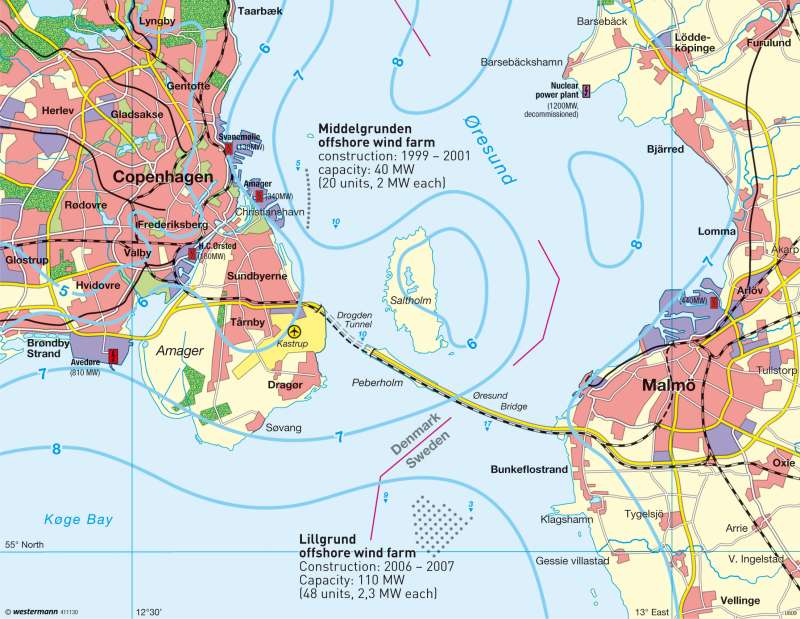Öresund — Offshore wind farms
Europe - Energy
978-3-14-100790-9 | Page 49 | Ill. 3

Information
The strait of Øresund connects the Baltic Sea to the Kattegat. Here, two major offshore wind farms produce energy for the Danish and the Swedish grid.Middelgrunden
Between 1999 and 2001, the Middelgrunden wind farm was built east of Copenhagen. With its 20 wind turbines with a capacity of two megawatts, this was once the world's largest offshore wind farm. With a total capacity of 40 megawatts, it produces 89 gigawatt hours of electricity, equivalent to three percent of the energy consumption of Copenhagen. The 20 wind turbines are each placed at a distance of 180 metres, and form a slight curve with a length of 3.4 kilometres. The wheel hubs are located at a height of 64 metres and the wings have a diameter of 76 metres. Each wind turbine can operate independently from the others. The generated electricity is routed to the power plant in Amager.
The wind farm was built as collaboration between the Middelgrunden Wind Turbine Co-operative and Copenhagen Energy, which have built ten wind turbines. The entire project is managed by the SEAS Wind Energy Centre. Everyone involved in the construction firms were Danish.
The construction of wind farms was preceded by extensive studies. The present site was finally selected, and since the 1980's, was filled with rubble in its location off the port of Copenhagen, making the present water depth only two to six metres. In 1997 and 1998, two public hearings were held. After the first hearing, the original number of wind turbines of 27 was reduced to 20. In May 1999, the project received planning permission. Two years later, the wind farm was opened.
Lillgrund
Six kilometres south of the Øresund Bridge, is Lillgrund, the Swedish offshore wind farm. The wind farm was built between 2006 and 2007 and includes 48 wind turbines with a capacity of 2.3 megawatts. The wind farm is operated by Swedish utility company Vattenfall. An offshore substation combines the generated power and a power transformer enables the supply to the Swedish grid. The total installed capacity of 110 megawatts is enough to supply about 60,000 Swedish households. Both the wind turbines, as well as the infrastructure for the grid connection, were built by Siemens Energy.
Øresund Bridge
Since 2000, the Øresund connection has run between Copenhagen and Malmö, Sweden. The 16-kilometre road and railway connection consists of a tunnel, artificial island (Peberholm) and a 1092-metre-long cable-stayed bridge, which is supported by two 204 metres high pylons. In 2008, 25.7 million people journeyed over the Øresund bridge, of which 15 million travelled in passenger cars and 10.7 million by rail. An average of 19,400 units a day pass through the toll connection.
H. Kiegel; Ü: C. Fleming




